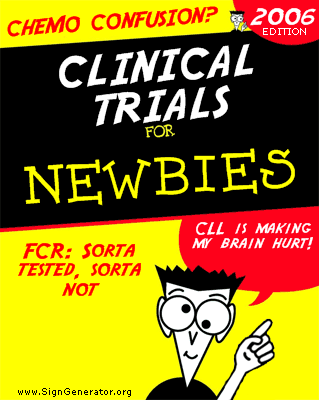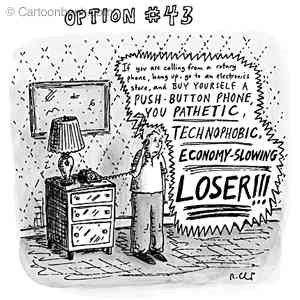To a newly-diagnosed patient who is told that he needs treatment, this is a tempting proposition. Only later did it sink in that “complete response” is never truly complete, and that depth of response may not correlate with how long you live, or what the researchers call “overall survival.”
Indeed, the central question about CLL therapy has not been answered: Given that one has a chronic disease that might span 20 or 30 years, will you live longer if you reduce the disease as much as possible at some point, even while taking on the additional toxicities of potent therapy, which might also lead to disease resistance to future therapy?

I hope to delve into that question soon, since it bears greatly on the treatment decisions that I am facing, and that all of us face. But for now, it is enough to look at the question of clinical trials. As a new patient, I had assumed that these trials are pretty much the same, and that the bigger the name of the institution, the more reliable the results.
Today I am older and wiser.
The question of how trials are conducted goes to the heart of the usefulness of the data we have on FCR. What I am learning is that, on one side, we have respected CLL researchers such as Dr. Terry Hamblin and the CLL team from Ohio State University, who argue that randomized, controlled, phase III trials are essential. And on the other side we have MD Anderson, equally respected, which regards them as unnecessary.
As in many things CLL, the experts disagree.
The traditional approach
Dr. Hamblin's article Are We There Yet? at CLL Topics argues in favor of randomized, controlled trials, or RCTs -- which is not the method used by MD Anderson in evaluating FCR.
States Hamblin: "The only way to satisfactorily compare two treatments is by a head-to-head, randomized, controlled clinical trial of sufficient power to distinguish between the treatments. . . . RCTs like this are called phase III trials. When there is no comparison, except with what went on in the past (so called historical controls) the trials are called phase II trials. The MD Anderson Cancer Center is a great champion of phase II trials. For CLL they have done large phase II trials of fludarabine combinations. Two in particular are important: fludarabine and cyclophosphamide (FC) and FC plus rituximab (FCR). . . . because the patients weren't randomized between the various types of treatment we do not know whether they were similar groups. All these studies do is provide justification for an RCT."
In an online post entitled "Clinical trials," Dr. Hamblin wrote:
"The randomized clinical trial is an invention as important as the airplane or the computer. . . . Both patients and doctors want the disease to be cured. No matter how objective we think we are, studies have shown that we have an unconscious bias towards certain results. This is why we randomize, to take away that unconscious bias. . . .
"With some of the drug combinations that we have today we have lots of information about short term effectiveness. We know that FCR, for example, produces a very high remission rate, and those remissions are quite long, on average. But because we have not had a randomized controlled trial, only comparisons with what has happened in the past, it remains a treatment that's not always available and one that hasn't really won its spurs. We don't know for instance, whether responses occur in patients with less severe disease, but less so with the more malignant forms, or what will happen to those patients who relapse (which probably means all of them, eventually). Will they respond a second time? Will they have a better overall survival than patients treated in other ways? Will there be long-term unforeseen side effects?
"Controlled trials of FCR are now taking place in Europe and worldwide, but not in America where the treatment was invented. I certainly hope that FCR proves as good as its supporters claim, but as of now, we don't have the evidence we should have."
The MD Anderson shortcut
MDA’s Dr. Michael Keating, the father of FCR, has not commented in much detail publicly on this question, but there was some discussion of it in a feature story that ran in MDA's Conquest magazine in 2004. The story, profiling Keating and MDA's CLL research team, can be found here. Some pertinent excerpts:
"In a period of 20 years, we've gone from an attitude of trying to control the disease with simple medicati
 ons to gaining a more realistic expectation of curing some patients with these combination therapies," Keating says. "Since we have an outstanding natural history database that includes every M. D. Anderson patient treated for leukemia since 1965, we've been able to track and record treatment responses and survival among these individuals."
ons to gaining a more realistic expectation of curing some patients with these combination therapies," Keating says. "Since we have an outstanding natural history database that includes every M. D. Anderson patient treated for leukemia since 1965, we've been able to track and record treatment responses and survival among these individuals."The “cure” question raised by Keating is the subject for another debate, but focusing on the question of trials, the author of the article goes on to state:
"Because the database has enabled Keating and his colleagues to better predict how well patients will respond to therapy, they have been able to move their clinical research forward without having to conduct any randomized, comparative studies.
“Such progress is due, in large part, to the work of Susan Lerner, manager of clinical protocol administration, and her team of 11 research data coordinators. She has worked on CLL with Keating since he began his studies in 1983.”
So the difference in positions could not be more stark. Is MD Anderson right to be thinking outside the box, as it were? And should I -- or should you -- bet my body on it? To put it another way, which is more trustworthy, Sue and her team, or a RCT?
MD Anderson is in Texas, where they like to think big, and MDA is known for its aggressive and varied clinical trials. We patients owe our heartfelt thanks to those who enter trials, at MDA or elsewhere, to help pioneer new therapies. There is no doubt that research progresses faster, and gets to market sooner, if one avoids the lengthy process of phase III trials. If one can leapfrog ahead, one may stumble upon useful things sooner, but one may also make more mistakes, and the unconscious bias Dr. Hamblin talks about might enter the picture.
So, is FCR really a chemo star?
Dr. Keating and the MDA team published two articles about FCR in the Journal of Clinical Oncology last year. One dealt with chemo-naive patients and the other with relapsed patients.
Their conclusions?
For naïve patients, “FCR produced a high CR rate [70%] in previously untreated CLL. Most patients had no detectable disease on flow cytometry at the end of therapy. Time to treatment failure analysis showed that 69% of patients were projected to be failure free at 4 years (95% CI, 57% to 81%).”
For previously-treated patients, “The FCR regimen was an active and well-tolerated treatment for previously treated patients with CLL. Myelosuppression was the most common toxicity. FCR induced the highest CR rate [25%] reported in a clinical trial of previously treated patients with CLL. Furthermore, molecular remissions were achieved in a third of patients achieving CR.”
Sounds good, right?
These studies were accompanied by an editorial written by Drs. Thomas Lin, Michael Grever, and John Byrd, all of Ohio State. The full text of the editorial is available here, and I highly recommend it to anyone considering FCR or the like.
The authors have some good things to say about the potential of FCR and combination chemoimmunotherapy. But they also have some direct warnings about the MDA data and against jumping to conclusions about new therapies before they are proven (boldface mine).
“The first report by Keating et al summarizes the results of fludarabine, cyclophosphamide, and rituximab (FCR) in 224 previously untreated CLL patients. Extraord
 inary clinical activity was observed, with CR in 70% of patients, nodular partial response (NPR) in 15% of patients, and partial response (PR) in 15% of patients. The OR rate was 95%, though the percentage of stage I and II patients was higher than in most earlier studies. It is unclear what proportion of these early-stage patients had symptoms.”
inary clinical activity was observed, with CR in 70% of patients, nodular partial response (NPR) in 15% of patients, and partial response (PR) in 15% of patients. The OR rate was 95%, though the percentage of stage I and II patients was higher than in most earlier studies. It is unclear what proportion of these early-stage patients had symptoms.”That last sentence is telling. One wonders at the implication. Could some of the MDA results be based upon early stage patients who, it might reasonably be argued by other doctors, did not really need treatment? (And beyond this, what are the results by disease profile --mutated v. unmutated, 13q v. 11q? Do “Bucket A” patients respond better or longer than those in “Bucket C,” and is there a preponderance of one or the other in the study? How were patients chosen, if not by a randomized method? Was there any “unconscious bias,” as Hamblin puts it?)
The Ohio State authors go on to discuss data from MDA as compared to that on FR from trials in the Cancer and Leukemia Group B (CALGB):
"Although the M.D. Anderson report by Keating et al and the CALGB comparison study both report highly encouraging results, one must remember that these findings still represent phase II, noncomparative data. The difference in patient demographics between these two studies, with younger, earlier-stage patients being enrolled onto the M.D. Anderson study, could be a major contributing reason for the difference in complete response rates between these two studies. At the present time, PFS [progression-free survival] between these two studies seems to be similar. With respect to both trials, one only needs to recall the excitement generated by highly aggressive combination treatments in the treatment of aggressive NHL in the 1980s. Similarly distinguished institutions reported phase II results that seemed superior to cyclophosphamide, doxorubicin, vincristine, and prednisone (CHOP), yet a phase III study by the Southwest Oncology Group showed that all three regimens were no better than CHOP. The value of multi-institutional, prospective, randomized phase III studies should never be underestimated.”
When the risks are potentially as great as the rewards -- not all patients gambling on FCR are winners -- and one has the luxury of doing something less risky (which I fully recognize that not everyone has), I believe it is wise to wait until the proper trials are done.
Unfortunately, MDA's reputation in the patient community, and among local US oncologists, can lead people to leap without thinking. It is assumed that the data is sound. In fact, the idea that some experts would find fault with it is almost inconceivable. But to err is human, and removing the human component from pivotal studies such as FCR is not only wise, it can also be a matter of life and death for patients.















